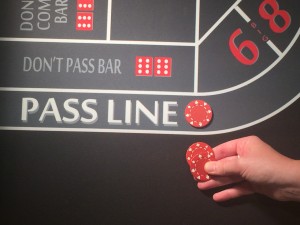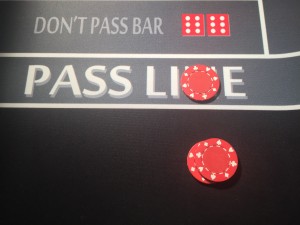Lesson Three
Playing the Pass Line – The Dice Will Pass
~Click on images to enlarge~
Okay, you have been introduced to some of the vocabulary of the game along with the basic instruction of the game and personnel. So far we have covered:
- Craps vocabulary
- Craps Mode and Dice Mode
- Craps personal – 2 dealers, 1 stickman and 1-2 boxman
- Starting a game, the Come Out roll
- Live numbers on the Come Out (Naturals) winners and losers
- 7-Out ends a game
- The buy-in, your cash traded for their cheques
- Shooting the dice, pick two dice – one hand only.
- Make a Pass Line Bet if you want to shoot the dice.
- Hit the back wall with both dice
- The dealers are working for you.
Let’s move on to a more detailed and important aspect of dice, Playing Right. This is otherwise known as playing the Pass Line. Typically, the Pass Line bet is the backbone of most betting strategies. This bet has the least house advantage (1.4%), so, any other betting is considered to be more aggressive after the Pass Line bet. (At least it is suggested here.)
The Pass Line bet is made during a Come Out roll. The Pass Line bet is a contract bet and pays even money when it wins. It wins when either a 7 or 11 rolls on a Come Out, or after the shooter repeats the point, (any of the box numbers 4-5-6-8-9-10). A point is established on the Come Out roll and can be any one of the box numbers.
The Best Kept Secret
There is a bet that is not advertised on the layout. The bet is called the Free Odds Bet, also referred to simply as the Odds Bet. Recall, from your study of the craps vocabulary, in order to make a Free Odds Bet, you must first have a Pass Line bet. Since there is a house advantage over the Pass Line bet, the term Free Odds is a bit misleading in my opinion. The Free Odds bet accompanies a contract bet, which is the Pass Line bet. In other words, you need to make a Pass Line bet in order to have a Free Odds Bet. So, it is not really free. Only that the Free Odds Bet is paid true odds, and it is free of the vig, (vigorish), a.k.a. the house advantage.
Okay, where do you make the Free Odds Bet on the layout? Just about every other craps bet allowed is labeled somewhere on the layout. Every bet except the only one having no house advantage. That’s right, there is a special place for this bet, but nowhere is it advertised on the layout. You have to know the secret location to make the Free Odds Bet. It’s as though the casino wants the Free Odds Bet to go unnoticed. Don’t worry, even with true odds, the odds still favor the losing roll, 7-Out. Enough already! Where is the bet located? The Free Odds bet is placed behind your Pass Line bet. See the picture. From this point on, I will discontinue the use of Free Odds and simply refer to the additional Pass Line bet as the “Odds Bet”. The dealers will be kind enough to remind you about the Odds Bet and where to place it if need be.
Note: Do not get into the habit of taking a dealer’s advice. Although it is true they are there to help you, they are still the employees of the casino. It is smarter to know the game, than depend on the casino personal to influence you with their knowledge about the game. It is not unusual for the salesman to come out, taking advantage of a recognized novice.
Notice the space between the Pass Line bet and the Odds Bet in the picture. It is about two inches, a bit more is okay too. The Odds Bet is not placed in or on the Pass Line field, but upon the apron of the layout, behind the Pass Line bet. The reason for the spacing is to prevent a die from landing between the chips and come to rest in a tilted position. This is known as a cocked die, when it happens.
Note: A cocked die can become a point of contention with some players, especially if the call goes against them. In the event of a cocked die, the stickman and/or the boxman makes the final call. The rule is simple, if the obstruction holding the die on tilt is removed, the face that would land on top, is the face called. It is pointless to argue with the game’s personnel over a call. It is their game and their rules. The house always has the last say.
The amount you may wager in Odds varies from casino to casino. It is recommended that until you have a command of the game that you stick with double odds in the beginning. Double odds is two times your Pass Line bet. If you have a $5 Pass Line bet, you make an Odds Bet of $10 (2 x 5 = 10).
The house advantage on a Pass Line bet with double odds is about .6%
When the Pass Line bet wins, you are paid even money for the Pass Line bet and true odds for the Odds portion of the wager. The true odds payout is determined by the point number. The payout for an Odds Bet is determined by the number of ways the point has to win, versus the number of ways it has of losing to the seven.
| 4 | 5 | 6 | 8 | 9 | 10 |
| 2 to 1 | 3 to 2 | 6 to 5 | 6 to 5 | 3 to 2 | 2 to 1 |
| Pays 2 units for every 1 unit bet | Pays 3 units for every 2 units bet | Pays 6 units for every 5 units bet | Pays 6 units for every 5 units bet | Pays 3 units for every 2 units bet | Pays 2 units for every 1 unit bet |
Let’s look at the 6 and 8, for example. Refer to the True Odds Table above. The 6 or 8 have five combinations of rolling.
The six has 1/5, 5/1, 2/4, 4/2 and 3/3.
The eight has 2/6, 6/2, 3/5, 5/3, and 4/4.
Those are the five ways of rolling 6 or 8.
The seven has six combinations of rolling.
1/6, 6/1, 2/5, 5/2, 3/4, 4/3
So, with the 6 or 8, we have 5 ways to win and with the 7, we have six ways to lose. Thus the odds for the 6 or 8 are 6:5 – True odds.
In this picture, a $5 Pass Line Bet with double odds of $10, is paid a total of $17. $5 is paid to the Pass Line bet, at even money, and $6 is paid for every $5 bet in odds.
You have two $5 chips in odds, a total of $10 in odds bet. 2 X $6 = $12. $12 + $5 = $17.
The Odds bet is paid true odds depending on the point’s box number, (4-5-6-8-9-10). Review the True Odds table above for more detail.
Some casinos offer raiser odds, and/or multiple odds greater than raiser odds. Again, when you are just learning, double odds will be adequate for you, win or lose.
There are six sides to a die and with two dice, there are thirty-six possible combinations. Below is a table of the thirty-six possibilities for rolling the eleven numbers. True Odds are determined based on the possible total of resulting combinations for each number.
| Number | Dice Combinations | Possibilities |
| 2 | 1-1 | 1 |
| 3 | 1-2, 2-1 | 2 |
| 4 | 1-3, 3-1, 2-2 | 3 |
| 5 | 1-4, 4-1, 2-3, 3-2 | 4 |
| 6 | 1-5, 5-1, 2-4, 4-2, 3-3 | 5 |
| 7 | 1-6, 6-1, 2-5, 5-2, 3-4, 4-3 | 6 |
| 8 | 2-6, 6-2, 3-5, 5-3, 4-4 | 5 |
| 9 | 3-6, 6-3, 4-5, 5-4, | 4 |
| 10 | 1-3, 3-1, 2-2 | 3 |
| 11 | 5-6, 6-5 | 2 |
| 12 | 6-6 | 1 |
Probability is expressed as a ratio comparing the number of ways to roll a certain number divided by the total possible combinations.
Examples: There is one way to roll a twelve, 6-6 and there are a total of 36 possible outcomes. Thus, the probability of rolling a twelve12 is one in thirty-six or 1/36. There are six possible combinations of rolling a seven. Thus, the probability of rolling a seven is 6/36 or 1/6, once in every six rolls.
True odds are expressed by the number of possible losing combinations compared to the number of possible winning combinations. Example: For the 6 or 8 the true odds are 6 to 5. Six ways of losing to five ways of winning, 6:5. The payout then, for an Odds Bet on either six or eight, is six units paid to every five units bet.
This concludes lesson 3 – Playing the Pass Line.
In review, the best bet in craps is a Pass Line bet with odds. The odds portion of the bet is paid true odds and thus reduces the advantage the casino has over the Pass Line bet to about .6%
In Lesson 4, you will learn how to make a Don’t Pass Line bet and Lay the Odds. Until then, may all your Come Outs be Front Line Winners with the dice passing!
Return to the Table of Contents
Copyright © 2006-2015 Michael Vernon – Playing 4 Keeps®





